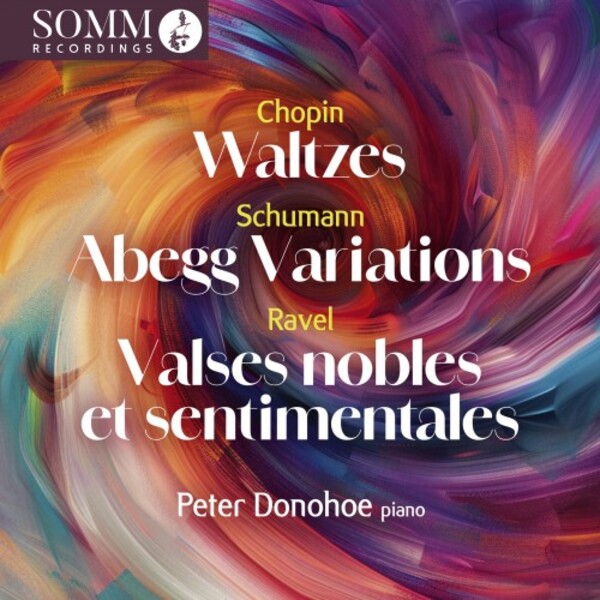Peter Donohoe: Waltzes
View record and artist detailsRecord and Artist Details
Genre:
Instrumental
Label: Somm Recordings
Magazine Review Date: AW2024
Media Format: CD or Download
Media Runtime: 82
Mastering:
DDD
Catalogue Number: SOMMCD0690

Tracks:
| Composition | Artist Credit |
|---|---|
| Waltzes, Movement: Nos 1-14 |
Fryderyk Chopin, Composer
Peter Donohoe, Piano |
| (La) Plus que lente |
Claude Debussy, Composer
Peter Donohoe, Piano |
| (8) Valses nobles et sentimentales |
Maurice Ravel, Composer
Peter Donohoe, Piano |
| Theme and Variations on the name 'Abegg' |
Robert Schumann, Composer
Peter Donohoe, Piano |
Author: Jed Distler
Peter Donohoe takes his time over the course of Schumann’s Abegg Variations, shaping the long phrases with expansive yet elegantly proportioned rubato, allowing the bass lines to sing out with more definition than usual. It’s a more genial and lower-voltage interpretation than the lean and scintillating Clara Haskil, Sviatoslav Richter, Evgeny Kissin and Lang Lang recordings, setting the tone for the 14 standard Chopin Waltzes up ahead.
The pianist devises a novel running order for the Waltzes that emphasises assiduous key relationships and contrasts of mood from work to work. His lyrically orientated E flat Op 18 dovetails into an attractively expansive A flat Op 69 No 1. Some of Donohoe’s emphatic melodic accents in the A flat Op 64 No 3 tend to impede the music’s songful flow, while one can argue that his ritardandos read too much between the D flat Op 70 No 3’s simple lines. On the other hand, his unpressured ‘Minute’ Waltz demonstrates how patience can indeed be a virtue. The same goes for the ‘2/4’ F major Op 34 No 3, where the cross-rhythmic patterns truly speak.
What richness and meaning Donohoe uncovers in the F minor Op 70 No 2. One could take dictation from the A flat Op 34 No 1’s embellishments, although I miss Rubinstein’s signature verve and élan. If the A minor Op 34 No 2 wanders to a fault, intriguing right-hand voicings justify Donohoe’s deliberation over the C sharp minor Op 64 No 2. And his concluding A flat Op 42 offers more variety in articulation and characterisation than might be apparent on first hearing.
Donohoe’s Ravel may not be the last word in shimmer and transparency, yet numerous details will catch listeners unawares. Note, for example, the precisely spelled-out left-hand accompaniment in No 3, or how a less than animé No 4 holds interest with inner voices to the fore. But why does Donohoe tread so gingerly through the vif No 6? However, the pianist casts a hauntingly time-suspending aura throughout the Épilogue, as if he’s reluctant to let the music end. The final selection, Debussy’s La plus que lent, commences in questioning, almost hesitant tones that gradually gather steam, leading into a memorable climax. I should also mention Somm’s superb sound and Robert Matthew-Walker’s insightful annotations.
Discover the world's largest classical music catalogue with Presto Music.

Gramophone Digital Club
- Digital Edition
- Digital Archive
- Reviews Database
- Full website access
From £8.75 / month
Subscribe
Gramophone Full Club
- Print Edition
- Digital Edition
- Digital Archive
- Reviews Database
- Full website access
From £11.00 / month
Subscribe
If you are a library, university or other organisation that would be interested in an institutional subscription to Gramophone please click here for further information.




